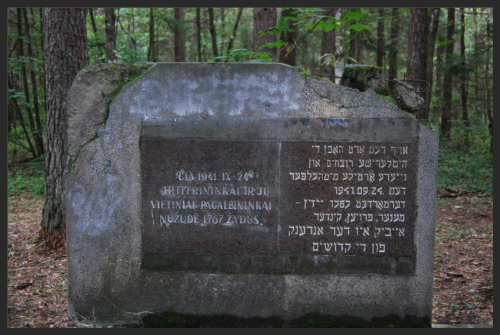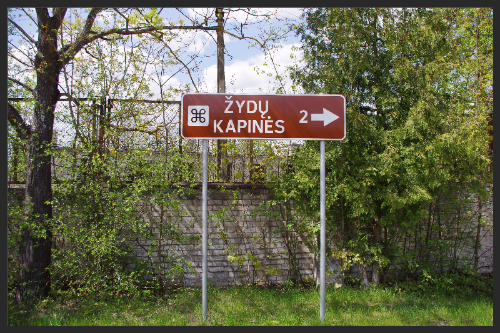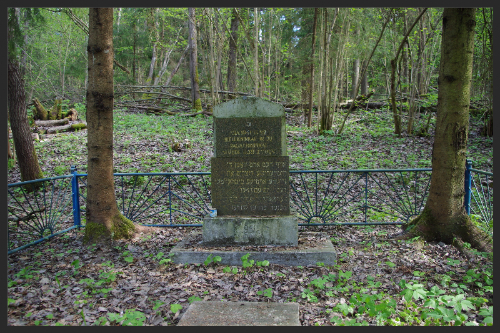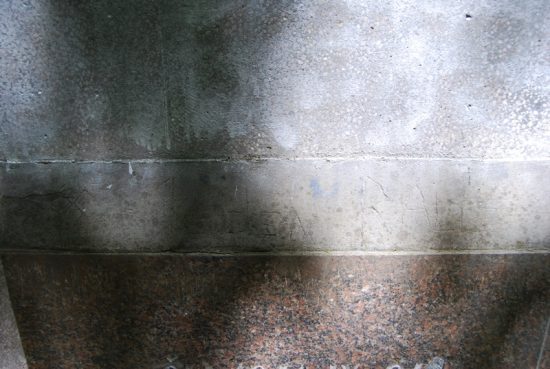CEMETERIES AND MASS GRAVES | COMMEMORATIONS | LITHUANIA
◊
by Julius Norwilla
◊
There are at least twelve Holocaust mass murder sites in the immediate Vilnius region that are marked by some kind of memorial. They are noted in the online Holocaust Atlas of Lithuania, founded by Milda Jakulytė. In Lithuania, there are over 227 such sites that are described in the atlas, which is historically a continuation of the painstaking 1990s work of the late Joseph Levinson, published in his The Book of Sorrow (Vilnius 1997) that documented close to 200 such sites.
The best known is the Paneriai Memorial as the largest mass grave in the country, known as Ponár in Yiddish and Ponary in Polish. It is the site where 100,000 people were humiliated and murdered, around 70,000 of them Jews. This is where official commemorations take place, particularly each year on September 23rd, the day (controversially) designated by the Lithuanian government as the Holocaust Remembrance Day, rather than the international day, on January 27th, or days specific to the Lithuania-wide Holocaust such as June 23rd when violence against and humiliation of Jewish neighbors broke out across Lithuania.
Other mass murder sites in the Vilnius region are visited much less frequently and very often — not at all. But visiting these places is important for the respect for those murdered there and for a deeper understanding of the Holocaust which has so distorted our nation’s qualities.
During the summer of 2016, I managed to visit and document all twelve sites and have been documenting their status and state of maintenance by photography, notes and video, and working toward their preservation via contacts with NGOs dedicated to preservation and contacts with police and other law enforcement in cases of desecration and vandalism. It was an honor and pleasure to be invited by Vilnius’s Jewish Cultural and Information Center on 4 August 2016 to give a talk and power-point presentation on this project, and to be able to share my discoveries, some quite shocking with a most distinguished audience that included Rūta Vanagaitė, author of the widely acclaimed 2016 book Mūsiškiai (see Defending History’s bibliography of international reaction to her book).
The twelve places I visited and documented, assisted by various colleagues, are here listed in chronological order of the date of massacre. Yiddish names (following, where available, forms on Prof. Dovid Katz’s list) are followed by Polish and current official Lithuanian names.
|
Yiddish |
Polish |
Current official Lithuanian |
Number of Victims |
Date(s) |
|
|
1 |
Ponár I |
Ponary I |
Paneriai I |
70,000 |
July 1941– July 1944 |
|
2 |
Rúdeshik |
Rudziszki |
Rūdiškės |
14 |
June 1941 (?) |
| 3 |
Podberéze |
Podberezie |
Paberžė |
35? |
July 1941 (?) |
| 4 |
Ponár II |
Ponary II |
Paneriai II |
60 |
21 July 1941 |
| 5 |
Nementshín |
Niemęczyn |
Nemenčinė |
403 |
20 Sept. 1941 |
| 6 |
Velitshyán |
Wieluciany |
Veliučionys |
1159 |
22 Sept. 1941 |
| 7 |
Vilenóve (?) |
Wilia Nowa |
Naujaneriai |
1,767 |
24 Sept. 1941 |
| 8 |
Yasún |
Jaszuny |
Jašiūnai |
575 |
25 Sept. 1941 |
| 9 |
Trok |
Troki |
Trakai |
1,446 |
30 Sept. 1941 |
| 10 |
Seméleshik |
Sumiliszki |
Semeliškės |
962 |
6 Oct. 1941 |
| 11 |
Némishke (?) |
Niemieżka |
Nemėžėlė |
240 |
8 July 1943 |
| 12 |
Bezdán |
Bezdany |
Bezdonys |
350 |
9 July 1943 |
|
Total Murdered |
77,011 |
Introductory information on each site is available on the online Holocaust Atlas of Lithuania at www.holocaustatlas.lt. In the atlas each site is provided with instructions for finding it, a small map and its geographical coordinates. It is only natural that with the passage of time omissions and errors can and will result in the project’s growth and improvement.
In most cases, while on the way to visit the sites and upon arrival in the nearest township — what used to be a Jewish shtetl — there are no signs indicating where to find the graves where so many of the town’s inhabitants (in some cases half or a majority) were killed and buried. When the site is deep in the forest and there is no local person around to ask, it is a challenge to find the old path. Nowadays a smartphone app can go a long way but what we have now has its limits. For example, I had to make three trips to Bezdán (Bezdany, today’s Bezdonys) before finally finding the killing site.
Many of the sites contain Soviet-era monuments, sometimes from the early years, right after the war, with inscriptions variously in one or more of the following: Lithuanian, Russian, Yiddish. While the Soviet-era monuments are sometimes summarily dismissed by twenty-first century memorialists, it is important to preserve the Yiddish (and frankly all) the inscriptions as important historic documents in themselves that are witness to historic eras. They should be preserved and supplemented by better and more accurate texts today. There is no lack of space in these forests.
The Yiddish texts often use the term היטלערישע רוצחים (hítlerishe rótskhim, ‘Hitler’s murderers’ or ‘Hitlerite murderers’) or its variant היטלעריסטישע רוצחים (hitlerístishe rótskhim, ‘Hitlerist murderers’). These terms are, in my opinion, characteristic of the Jewish parlance of the period, of the handful of survivors who did a lot in difficult Stalinist times after the war to ensure that these monuments were erected and that they included Yiddish texts. These Yiddish formulations ipso facto reject the Soviet term “fascists,” keeping the inscription remarkably far from the Soviet propaganda usages of all such terms, and managing to “get in there” a héymish (homey, intimate sounding) Yiddish word, rótskhim, the Yiddish plural of retséyakh (‘murderer’). These words derive from ancient Hebrew and came down a long line of Jewish history and living culture; in defiance of Soviet law on Yiddish spelling mandating “naturalization” (de-Hebraicization, phonetization) of spelling, they spell the ancient words historically (רוצחים and קדושים, not ראָצכימ and קעדוישימ as per mandated Soviet Yiddish spelling). Moreover, as it was impossible to name nationalities or self-identifications of the killers, the Yiddish hítlerish and hitlerístish, combined with the potent adjective órtike (‘local’, ‘from the area of the massacre’) said it all in a courageous turn of phrase that in many cases made it past the Soviet censors’ apparatus.
But finding the right words for the perpetrators has remained something of a struggle for monument text drafters right through to the present. The most general title in Lithuanian from various period is vietiniai talkininkai (‘local assistants’) which is in my own opinion absolutely incorrect. In the Vilna region the killing of Jews was centrally organized by the Germans and accomplished mostly by special armed Lithuanian forces in partnership with Lithuanian police units. With the exception of the sixty people killed in the forest near Rúdeshik (Rudziszki, Rūdiškės) at the onset (no. 2 in the chronological table above), the perpetrators at all these sites were primarily men of the Lithuanian “Special Squad” (Lithuanian: Ypatingasis būrys).
“Special Squad” is the euphemistic official language at that time used to refer to those who carried out much of the annihilation of Jewish population. The Special Squad, primarily composed of Lithuanian volunteers particularly drew members from the former paramilitary nationalistic “Union of Lithuanian Riflemen” (Lithuanian: Lietuvos šaulių sąjunga). The unit was subordinated to the German police, and some of the squad members continued to wear prewar Lithuanian Army uniforms until 1942. In Vilna, the Special Squad acquired a colloquial name deriving from its past and present: “The Ponary riflemen” (Lithuanian: Panerių šauliai). To organize mass arrests, transport Jews to the venues of imprisonment or execution, and, in order to avoid any incident act of resistance at execution, “preparation” of the victims for the violent death was the contribution of the Lithuanian Security Police officials and units.
If we look at each one of the dozen sites as a criminal mass murder case, we rapidly find what an enormous task to describe even one of them. In this introductory article, we will comment on issues arising from two of the sites, and follow up on the others in the next installment.
◊
Velitshán (Wieluciany, Veliučionys)
Velitshán (Wieluciany, Veliučionys) is 10 kilometers east of the center of Vilnius. The Special Squad arrived there Monday, 22 September 1941 and killed 1,159 Jews. children, women, and men. When we visited the site for the first time in May, local people willingly showed us the way. At the town’s main street there is big sign marking the way to the “Jewish cemetery” (Lithuanian: Žydų kapinės) two miles to the right.
No information is provided about what kind of “cemetery” it is and how to find it. When asked, local people said the Jews had been killed at several places or that the buried had been exhumed. A very confused picture. From the Atlas we know there should be a marker stone at the edge of the forest (these markers across the land were the result of a project spearheaded by the late Lord Janner of the UK). This particular marker is easy to find. Inspecting the stone, we see the black granite is intentionally defaced, but following its directions we enter the forest. The erstwhile “forest” is increasingly a luscious countrified suburb sporting many houses for the comfortable classes of the capital who dream of living in the beauty of the nature just outside. But at the edge of the forest we see stacks of plastic sacks filled with household garbage. The sacks are from nearby new houses are a sign of well-off families. I visited the site and this forest two times and the second I saw more stacks of garbage bags. This luscious forest area is in danger of turning into a shallow landfill very rapidly.
In the forest we spent at least an hour walking is search of the mass grave and almost gave up. The marker stone is in the wrong place. (But earlier this month, September 2016, following our public notice of the misplaced stone, it was moved to another place.) After the hour’s search and inquiring of people already at the other edge of the contained-area forest, we finally found the site and the monument.
The site is on the slope of a hill, on the other side from the perspective of the township, deep among dense woods, an almost “secret garden” setting. Most probably the killers chose this place to reduce the chances of accidental witnesses, of victims’ chances to escape, and to better ensure that the sounds of the cries of the dying and the shots of the killers would less likely be heard in town, just 800 meters or so away.
The site is one of those visited very infrequently. The monument plaque is in two languages: Lithuanian and Yiddish.
The Yiddish Text at Velitshyán (Wieluciany, Veliučionys):
אויף דעם אָרט האָבן די היטלערישע רוצחים און זייערע אָרטיקע מיטהעלפער דעם 22 09 1941 דערמאָרדעט 1159 יידן: מענער, פרויען, קינדער
1951
The Lithuanian translates: “Here on 22 Sept. 1941 Hitlerists and their assistants killed 1,159 Jews.” The text in both Lithuanian and Yiddish is close in meaning except that the Yiddish adjective órtike (literally “ones from here”) is added in Yiddish, giving the meaning “local assistants” while the Lithuanian text leaves it as just “assistants” (who could have been from anywhere, say, theoretically, Germany). Moreover, the text in Yiddish adds three words: men, women, children.
These details are important, and giving the thought, argumentation and process in the creation of very brief texts for monument text we can assume that much effort and not a little risk went into each of “those added words.” The only sign of visitors is a traditional Jewish candle in a special can with Hebrew characters. During this first visit in May, the first thought was it must have been Ruta Vanagaitė and Efraim Zuroff, who brought this candle there in summer 2015 while working on the book Mūsiškai.
I am among those who are sincerely grateful to Rūta Vanagaitė for her organized campaign to attract general public attention to the less visited mass killing sites all over our country and for organizing a public event at Velitshyán at 5 PM on the 23rd of September 2016 (three hours after the annual official ceremony at the Paneriai memorial). It is an important civic initiative that will give the general public in Lithuania an opportunity to express their thoughts and feelings at one of the very nearby sites of the violent death that came upon more than 200,000 Jews in our country.
◊
Vilanóve (Wilia Nowa, Naujaneriai)
After killing 1,195 people on Monday and Tuesday, 22 and 23 September 1941 at Velitshyán, the Special Squad rushed on Wednesday, 24 of September 1941 to Vilanóve (Wilia Nowa, today’s Naujaneriai) and killed there 1,767 Jews. This site is 12 km north of the center of Vilnius (no. 7 in the table above).
During the summer of 2016 we visited the site three times. The area boasts a very beautiful landscape close to the banks of the Viliya river (the Neris). At the outskirts of Vilanóve, there is a big road sign marking the way to “Holocaust victims’ graves 1” (Holokausto aukų kapai 1). From the Atlas we know there should be at least two markers: one at the edge of the forest and the second well within the forest. The road is through a now densely built-up area and it is not clear which turn we should take entering the forest. When in the forest, these are a few roads. Which one? It took some time to find the right one.
The site is very similar to the site in Velitshyán. The mass grave’s assumed borders are marked with stones. The monument inscription is in Lithuanian and Yiddish. “On this site Hitlerists and their local assistants on 24 September 1941 killed 1,767 Jews, men, women, children. Eternal is the memory of innocent victims. The Yiddish text reads: Af dem ort hobn di hítlerishe rótskhim un zéyere órtike míthelfer dem 24tn September 1941 dermórdert 1,767 yidn, méner, fróyen, kínder. Éybik iz der ondeynk fun di kdóyshim (“At this place the Hitlerite murderers and their local assistants on the 23th of September 1941 murdered 1,767 Jews — men, women, children. Eternal is the memory of the sacred martyrs.”) Kdóyshim (modern Hebrew kedoshim) is a special Jewish term, derived from the ancient Hebrew for “holy ones” but it has over many centuries acquired in Yiddish the sole meaning of “people who were murdered just because they were Jews” or in the case of earlier Jewish calamities where conversion to save oneself was an option, “people who chose to sanctify God’s name.” The Lithuanian text is shorter, lacking in some of the Jewish sensibility (the need to identify local participants) and such religious-cultural texturing as could be inserted in the dark days of Stalinism.
The Yiddish Text at Vilanóve (Wilia Nowa, Naujaneriai):
אויף דעם אָרט האָבן די היטלערישע רוצחים און זייערע אָרטיקע מיטהעלפער דעם 24 09 1941 דערמאָרדעט 1767 יידן — מענער פרויען קינדער
אייביק איז דער אָנדענק
פון די קדושים
◊

During the dark Stalinist years that followed the Holocaust, Lithuanian Jews sometimes dared to express a lot more in the “Yiddish half” of bilingual inscriptions, both in cultural and religious content and nuance, and in specific reference to local participation in the genocide. These monuments should be preserved and supplemented by 21st century works, but not removed or destroyed. They are an important part of the history reflecting on the work and ethos of the small number of survivors after the war, and their own struggle for their people’s beliefs and their knowledge about the Holocaust to find expression.
During our first visit to today’s Naujaneriai (Vilanóve, Wilia Nowa), while trying to make some minimal order out of pieces of the monument that had been smashed, we found a Nazi swastika and the words “Juden raus” inscribed right within the frame of the plaque. My own view is that it was inscribed in the cement before the cement was dry and dates to the last cementing over of this frame.
I hastened to send a letter about the desecration of the mass murder site and the particularly disgraceful antisemitic inscription, both to the official Jewish Community of Lithuania and to the police. These events were reported last May in Defending History. My letter to the police was kindly posted on the Jewish Community’s website.
The Vilnius city policy opened an investigation. I have been in regular touch with the police who continue to tell me they have nothing yet to report. And, when we visited the site for a third time two months later, in August 2016 we found new marks of desecration. In the interim, the monument and plaque were tarnished with paint and an unreadable inscription. The swastika and “Juden raus” we had discovered and reported to the police were still there too.




